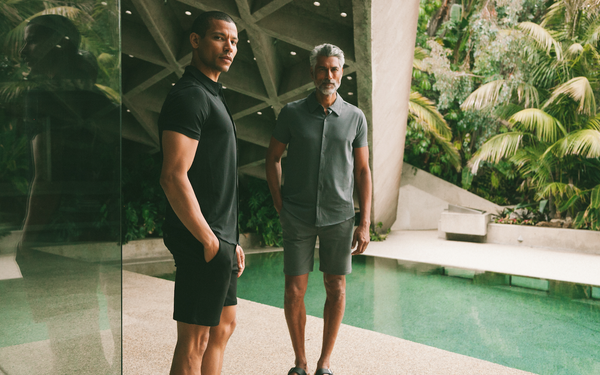Commentary
True Classic CEO: 'Too Many D2C Brands Don't Understand Creative'
- by Sarah Mahoney , Staff Writer @mahoney_sarah, July 3, 2023

Ryan Bartlett started True Classic, a T-shirt company, with $3,000 and the conviction that many D2C brands don't know how to make creative content. He's even more convinced four years and $250 million in sales later. He tells D2C Insider how True Classic is using its content success to expand, with spots created in-house like “A Brief Western,” “Dad Jokes,” and “What’s wrong with his face?"
D2C Insider:You've got an odd background for apparel. You used to be a professional poker player, then spent a decade building SEO Direct, an agency, before launching True Classic in 2019. And it's grown fast. How did you get here?
Ryan Bartlett: I started the company because I wanted a good T-shirt that wasn't expensive. Everything out there was kind of standard format and standard build. It didn't look good on the average guy's body. So I thought, let me do this as a side project, creating just one SKU, built super-intentionally. So I found partners, one who knew apparel and one who knew start-up finance.
D2C Insider:What was the initial price point?
Bartlett: The first T-shirt was around $12, which lasted a month before we realized it was [priced] too low. But keeping the price low was important. I was tired of being gouged for a premium T-shirt for $50, $60 or $70. I wanted to keep it in the teens. Most importantly, we wanted a consistent fit, so you know that if you're a medium in our T-shirt, you'll be a medium in our polo. We want the experience to be very simplified.
D2C Insider: How much are they now?
Bartlett: Singly, like $22 or $23, but no one buys singles. Everyone buys the packs. Then it's more like $16 or $17 a shirt. We think of them as elevated basics. When you compare them to something from Target or Walmart, you'll immediately notice the difference in quality. The way the shirt is sewn together makes you look slimmed down if you're a bigger guy, and like one who works out if you're smaller.
D2C Insider: You're planning to expand into women's wear. How much different is that?
Bartlett: So we solve two problems for men: fit and price.
And we're going to do the same thing for women. Unless the women we're testing with can honestly say it makes them look and feel better, I'm not releasing it. We initially thought we might be ready for the fourth quarter of this year, but now we're talking about February. It's complicated. It has to be a premium shirt -- on the same quality level as a Lululemon or Vuori -- but at a quarter of the price.
D2C Insider: What's your approach to marketing?
Bartlett: We usually fit our creative into four buckets, with about 25% comedy, 25% user-generated content, 25% kind of informative and edutainment, and 25% in-house, which is a combination of a lot of different styles. We'll change when we start to introduce women's. Guy comedy is just different. For women, we'll likely focus more on the value proposition.
D2C Insider:Many people have speculated that the D2C model no longer works. Do you agree?
Bartlett: We do have five retail stores opened this year. We're in Chicago, San Jose, Los Angeles and Washington, D.C. But I'm not sure we'll do a big rollout. It's pretty close to break even, and unless it's profitable, it's hard to scale it without raising money. We tend to do things slowly and make sure they work first.
As far as the D2C landscape, we win because we think differently about the content that we create. This narrative that D2C has gone downhill is built around people that don't understand creative. They don't know how to get to the customer, and more importantly, they don't understand what the customer wants to see.

D2C Insider: Can you say more about that?
Bartlett: I have a lot of co-founder and CEO friends, and they'll ask me, "Why are we struggling?" And I'll go to their social pages; their content is often terrible. And I'll say, "Your customer acquisition relies on social, but your content isn't resonating with people. So why would you expect them to buy your stuff?" They don't seem to have anyone saying, "This is B- level content."
Content needs to be redone, reiterated and rethought and retested before it gets deployed into the world, and they don't get it. There is this massive disconnect. People think they've made something beautiful and are shocked when it doesn't work. There's just not enough objectivity.
It's like artists would never only paint with one color, right? So their creative doesn't work, and they spend more and complain about the high cost of acquiring customers. Good creative is the gateway to lower CAC. Look at companies like Liquid Death or us.
D2C Insider: You're launching a campaign using poker chips, which you're distributing at the World Series of Poker in Las Vegas. How did that come about?
Bartlett: I started making these poker chips with a QR code that leads to a free T-shirt for when I was out and about in the world. Like I'll give them to the UberEats driver. It's amazing because people don't expect presents.
That kind of bled into the World Series sponsorship idea. It's a game. There are two cards on the chip, and to see if they win the hand, they scan the QR code, and then they'll see their hand play out against the dealer. If they win, it leads to a free product. It's fun and feels a little like gambling.
We don't know yet how fruitful it's been because the World Series is still going on, and we didn't expect people to do it during the tournament. But we're definitely getting a lot of traffic.



